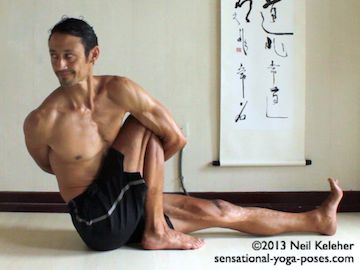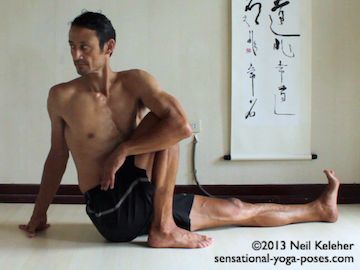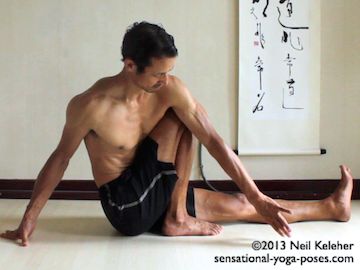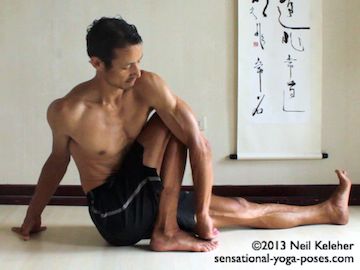Making binding easier in Marichyasana C
Lengthening your spine so that twisting (and then binding) is easier
In marichyasana C, the non-marichyasana leg is straight. You twist and bind the marichyasana leg from the outside.
This pose can be challenging if your thighs are short compared to your body. One way around this may be to work at pressing your shoulder down. If twisting to the right (with the left leg in marichyasana) the work at pressing your left shoulder down to making binding easier.
Steps Towards binding in Marichasana C
Assuming your are twisting to the right, (and assuming you haven't got the above mentioned issue) the first step is to get your arm to the outside of your thigh. This by itself won't be enough to get you to bind but it is a first step.
Making your spine feel long for a deeper twist
To make twisting your spine easier, work at making your spine feel long. You'll be using your spinal erectors among other muscles. When you can feel that your spine is long, you can use the same muscles that are making your spine feel long to help twist your spine to the right.
Feel and adjust the muscles of your ribcage to make the twist deeper
To make the twist even easier, work at feeling the front, sides and back of your ribcage. You could try to focus on only one side of your ribcage (the front, or the back, or the left, or the right). Use whichever variation makes it easier for you to twist to the right.
Other ways to make twisting easier are to "slide" your ribcage forwards or backwards or left or right relative to your pelvis.
Note that because of the sternum, it can be helpful to think of the ribcage in terms of the upper half and lower half.
- The upper half of the ribcage consists of 7 ribs and includes the ribs that directly attach to the sternum.
- The lower half of the ribcage consistes of 5 ribs and includes the floating and false ribs.
Because of the sternum, the upper half of the ribcage tends to be stiffer, and thus more difficult to twist, than the lower half. So when twisting, to improve your twist, work at adjusting your upper ribcage to make the twist as deep as possible.
Using muscles that twist the lumbar spine and sacrum
Note that your lumbar spine has muscles that can be used to twist it. In addition, you may get some slight twist from the Sacrum and SI joints. If, when lengthening your spine, you can feel your whole spine, from the sacrum to the base of the skull, this is a good indication that muscles are active all along the spine. You can the try to use these muscles to gradually deepen your twist.
Note that to drive sensation in a twist, your muscles will be working in opposing pairs. So not only does making your spine feel long make it easy to feel your spine, the same muscles that generate this sensation are also working against each other to stabilize the multitudinous intervertebral joints.
Activating your hip muscles in marichyasana C
When twisting at the sacrum and lumbar spine, (or when trying to use muscles that work on or from the sacrum and hip bones), it can be a very good idea to stabilize the hip joints. For the straight leg in marichyasana C, try reaching the knee away from the hip joint. Failing that, work at making the whole leg feel long. Another trick is to simply make the knee feel strong.
Activating the bent knee hip in marichyasana C may be a bit more tricky. Prior to binding (or as you are trying to bind), try pressing down through your forefoot or heel to make the hip active. This may actually be easier when you try to bind since the tendency may be for you to shift weight onto the marichyasana foot. Note that prior to binding, you may have a hand on the floor behind you. If this is the case, make sure that you deliberately press the marichyasana foot down to help activate the hip muscles of that leg.
Using your shoulder to help bind marichyasana C
Once your spinal twist is deep enough and you can get your elbow to the outside of your thigh, work at pressing your shoulder down so that your elbow is at or past the front of your shin. In this regard this pose is similiar to grabbing a wrist and binding in Ardha Matsyendrasana. However, instead of passing the forearm between the shin and thigh, you are trying to wrap it form around the front of the shin.
Working on the Bind
Once your arm is reaching far enough forwards you can use your other hand to try to push your forearm to the outside of the shin and thigh. Or work at using your shoulder and arm muscles to internally rotate the arm so that this happen.
Note here that the arm action you are trying to do in order to bind (internal rotation with the elbow to the side or even forwards of the ribcage) is very similiar to that used in the penguin shoulder stretch.
Once you get the forearm under your thigh, try to hook it against the thigh so that you have some stability. You can then reach your other hand behind your back to try to grab it.
Published: 2017 11 16
Updated: 2020 10 19






